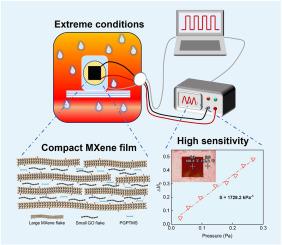共价嵌入的MXene/石墨烯复合薄膜使极端条件下的超灵敏声学传感器成为可能
IF 11.6
2区 材料科学
Q1 CHEMISTRY, PHYSICAL
引用次数: 0
摘要
开发能够在极端环境下运行的高灵敏度传感器是特定智能技术发展的迫切需要。具有高导电性的大MXene层被广泛用于组装高性能传感薄膜。然而,大量重叠的MXene层之间的间隙会降低机械性能,并加速层与空气/水的氧化。在这里,我们提出了一种共价插入的MXene基复合传感膜,它提供了高拉伸强度和抑制空气/水渗透,这是通过一个小的石墨烯层与大的MXene层共价互连,然后使用3-缩水氧基丙基三甲氧基硅烷(PGPTMS)交联来实现的。因此,使用这种强抗氧化传感材料的传感器即使在极端条件下(200oC和100%相对湿度),也能以1728 kPa−1的高灵敏度识别出特征微弱的声音信号(<0.27 Pa)。这项工作为构建高灵敏度和环境适应性相结合的传感器提供了一种强大的界面工程方法。本文章由计算机程序翻译,如有差异,请以英文原文为准。

Covalently intercalated MXene/graphene composite film enables ultrasensitive acoustic sensors under extreme conditions
Developing sensors with high sensitivity, capable of running in extreme environments, is highly desirable for specific intelligent technology development. Large MXene layers with high electrical conductivity have been widely used to assemble high-performance sensing films. However, the gaps between the large overlapping MXene layers would degrade mechanical performance and accelerate layer oxidation with air/water. Here, we propose a covalently intercalated MXene-based composite sensing film affording high tensile strength and suppressed air/water penetration, which is achieved by a small graphene layer covalently interconnected with large MXene layers, followed by cross-linking using 3-glycidoxypropyltrimethoxysilane (PGPTMS). As a result, the sensor using this strong and anti-oxidation sensing material could identify featured weak sound signals (<0.27 Pa) with a high sensitivity of 1728 kPa−1 even under extreme conditions (200oC and 100 % relative humidity). This work provides a robust interfacial engineering approach for building sensors combined with high sensitivity and environmental adaptability.
求助全文
通过发布文献求助,成功后即可免费获取论文全文。
去求助
来源期刊

Carbon
工程技术-材料科学:综合
CiteScore
20.80
自引率
7.30%
发文量
0
审稿时长
23 days
期刊介绍:
The journal Carbon is an international multidisciplinary forum for communicating scientific advances in the field of carbon materials. It reports new findings related to the formation, structure, properties, behaviors, and technological applications of carbons. Carbons are a broad class of ordered or disordered solid phases composed primarily of elemental carbon, including but not limited to carbon black, carbon fibers and filaments, carbon nanotubes, diamond and diamond-like carbon, fullerenes, glassy carbon, graphite, graphene, graphene-oxide, porous carbons, pyrolytic carbon, and other sp2 and non-sp2 hybridized carbon systems. Carbon is the companion title to the open access journal Carbon Trends. Relevant application areas for carbon materials include biology and medicine, catalysis, electronic, optoelectronic, spintronic, high-frequency, and photonic devices, energy storage and conversion systems, environmental applications and water treatment, smart materials and systems, and structural and thermal applications.
 求助内容:
求助内容: 应助结果提醒方式:
应助结果提醒方式:


